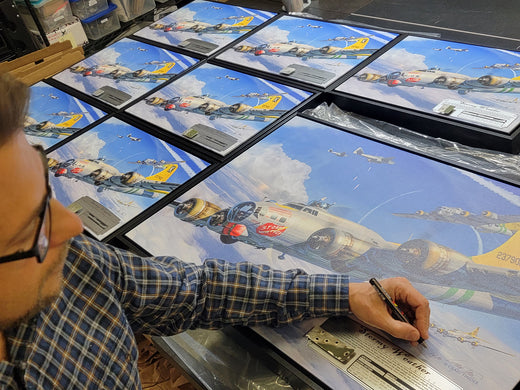This Fine Art Print by Artist Craig Tinder depicts the 11 March 1945 mission of the B-17G Flying Fortress "High Tailed Lady" of the 487th Bombardment Group en route to the Luftwaffe airfield in Babenhausen, Germany, and includes an authentic relic from a B-17 Flying Fortress.
Details about the RELIC:
This B-17G Flying Fortress wing skin originated from B-17G-95-DL 44-83872 (BuNo. 77235), known as "Texas Raiders" during a significant wing spar restoration in 2001. This particular artifact originated from the outer wing segment of the port wing. The artist was a Loadmaster and restorer of this aircraft and personally acquired this material during these restoration efforts.
 B-17G-95-DL 44-83872 aluminum panels removed during restoration process
B-17G-95-DL 44-83872 aluminum panels removed during restoration process
 B-17 Flying Fortress fragment mounted for "Stormy Weather" artwork
B-17 Flying Fortress fragment mounted for "Stormy Weather" artwork
 Artist, Craig Tinder, signing a limited edition canvas of "Stormy Weather"
Artist, Craig Tinder, signing a limited edition canvas of "Stormy Weather"
The Story Behind the Print:
On 11 March 1945, 33 B-17G Flying Fortresses from the 447th Bomb Group of the U.S. Army's 8th Air Force embarked on a critical bombing mission over Hamburg, Germany. Taking off from England at 0920 hours, the heavy bombers climbed into a sky that promised resistance from both the German Luftwaffe and unpredictable weather conditions. As they approached the target area, they encountered thick cloud cover, making it difficult to locate their objective.
Despite the challenges, the crews pressed forward, fighting off enemy aircraft and relying on their skilled formation flying to protect one another. After several tense moments over the target, the bombers found a break in the clouds, allowing them to unleash their payload. A total of 78 tons of bombs rained down on Hamburg's strategic sites. The force of the explosions was so intense that it generated an updraft, clearing the remaining cloud cover and revealing the devastation below.
Luckily, all 33 B-17s from the 447th Bomb Group completed the mission and returned to base without loss. This successful operation exemplified the resilience and precision of the U.S. 8th Air Force in the final months of World War II, contributing to the ongoing strategic bombing campaign that severely weakened Germany's war capabilities.
To purchase or see similar items, visit here.
Commissioned by Museums, Treasured by Collectors





Share:
PANORAMIC Prints Coming Soon!
Warbirds Over The Beach Airshow - 2021